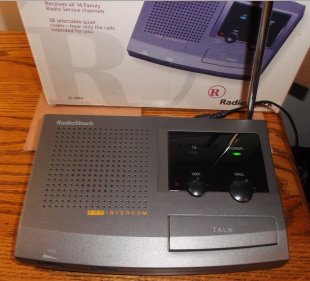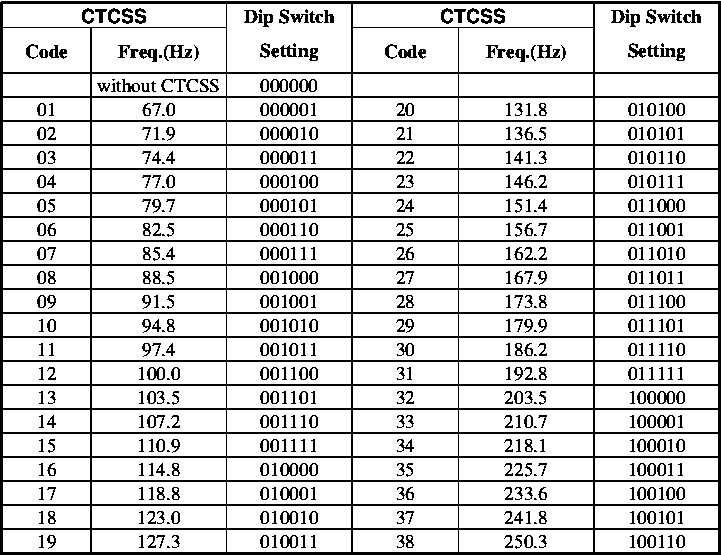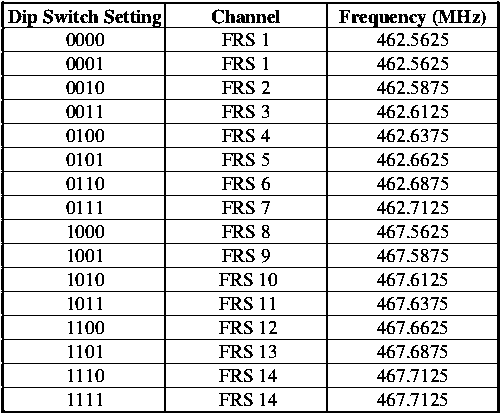RadioShack 14 Channel FRS Base Station 21-1845
AC-Powered Intercom 2-Way Personal Radio - 14 Channels (single)
Catalog # 21-1845
This is a type of wireless intercom, however, unlike previous Radio Shack wireless intercoms, this uses an over-the-air Ariel transmitting antenna rather than placing RF directly into your home electrical system.
This is an A/C powered wireless intercom using the FRS portion of FRS/GMRS radio frequencies.
Contents
Features
This unit has 4 channels and 38 different QUIET (CTCSS) codes. If someone else is using the channel you selected and you do not want to hear that person, select another channel, or use the QUIET feature. You can talk with a person who has a FRS radio if both radios are tuned to the same channel and QUIET (CTCSS) code.
Your radio has auto-squelch, which means you will not hear anything on a channel unless someone is transmitting nearby on the same channel. You can turn off auto-squelch to hear weaker, distant transmissions. You can connect an optional speaker/microphone and earphone to the radio. The VOX operation brings you convenient hands-free use.
This model has a separate mic and speaker jack on the side.
Specifications
- RX Frequency: 462-467 MHz
- Channels: 14
- Modulation type: FM
- Antenna impedance: 50 Ohm
- Microphone: condenser type
- Power supply: 9 VDC 500mA - [Transformer]
- Sensitivity at 12dB Sinad: 0.5μV
- Adjacent Channel Rejection: 45dB
- Audio Squelch: Auto
- Audio output power: 500mW @ 8 Ohm
- Audio Distortion: 5%
- RF Output Power: 500 mW ERP @ 9 VDC
- Harmonic Emissions: more than 50dB
- Dimensions (HWD: 36×178×120mm
- Weight: approx 350g
Review
Over the years the many models of Radio Shack intercoms varied in quality and reliability. In reviewing many different models the RadioShack 14 Channel FRS Base Station 21-1845 seemed to have the greatest overall appeal for most home or small office installations. The use of CTCSS tone encoded squelch helps to overcome some of the issues with FRS congestion in urban settings. It should be mentioned that although CTCSS is sometimes referred to as privacy codes this provides absolutely no privacy against eavesdropping on external FRS receivers, it is simply a way to reduce or eliminate unwanted radio interference from nearby transmissions. The units required frequency and tone set by small dip switches on the bottom, which might be too confusing for some users. It can easily be argued the dip switch method has some clear advantages. Later models suffered from "too many buttons" on the top and could easily be tuned off frequency by accident. As long as you had one competent person in the office or family to set the dip switches, you could be confident every intercom remained on the correct channel with the correct CTCSS tone setting. As long as you did not discuss private matters on the intercom system, these units really were some of the best wireless intercoms ever produced by anyone. Had Radio Shack made a unit that required use of the dip switches to set the frequency and tone, yet were on the 800Mhz frequency range, they would have had a best wireless intercom ever made.
Setting Channel Frequencies and CTCSS
On the station bottom, you will find two arrays of dip switch. These switches are used to set the channel frequency, and CTCSS code.
Radio Shack calls it Quiet, or QUIET code and what they are referring to is Tone Encoded Squelch (CTCSS or PL Tone). This prevents radio interference from coming though your radio (breaking squelch) unless the radio signal is accompanied by the correct sub audible tone. This is not a scrambling technology, it does not give your conversation any greater privacy against other people listening in with a radio receiver, it just helps keep other radio activity on the frequency from coming through your radio so that you are able to monitor with less noise and interference.
Setting for 38 CTCSS Code
The first array of 6-digit dip-switch is used to set 38 CTCSS codes. Please find below table for setting.
Setting for Channel Frequencies
The second array of 4-digit dip switch is used to set any one of the 14 channel frequencies. Please find below table for setting.
Related
- RadioShack 14 Channel FRS Base Station 21-1845
- RadioShack 22 Channel GMRS FRS Base Station 21-1846



